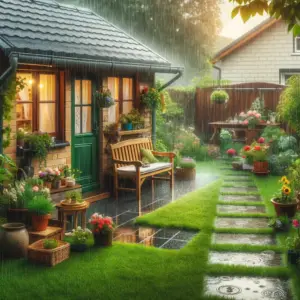
If you live in a particularly stormy area then you want to make sure you choose solar lights that have high ratings for water resistance, but are solar lights waterproof?
Generally speaking, solar lights should be water-resistant and stand up to average amounts of rain but you may want to bring them in during severe storms. Hanging lights tend to fare better than garden lights since rain and snow and drip off of them.
Let’s have a look at some of the questions you have probably found yourself asking and provide the answers to them.
Table of Contents
Why Waterproofing is Important
Challenges Posed by Outdoor Elements (Rain, Snow, Humidity)
Solar lights, by their very nature, are designed for outdoor use, which exposes them to a variety of weather conditions. These conditions include rain, snow, and humidity, each presenting unique challenges:
- Rain: The most immediate threat to non-waterproof solar lights is rain. Water can seep into the internal components, leading to short circuits and corrosion. This is especially true for solar lights with poorly sealed battery compartments or exposed electrical connections.
- Snow: Snow presents a dual challenge. First, accumulated snow can block solar panels, reducing their efficiency. Secondly, as snow melts, it can infiltrate the light’s casing, similar to rain, and cause damage to the electronic components.
- Humidity: In areas with high humidity, moisture in the air can condense inside the solar light, particularly in the cooler evening hours. This condensation can lead to rusting of metal parts and degradation of electrical connections over time.
Impact of Water Damage
Water damage can have several detrimental effects on solar lights, affecting both their performance and lifespan:
- Reduced Efficiency: Water intrusion can obscure solar panels, reducing their ability to charge the battery effectively. Additionally, corrosion of electrical connections can lead to reduced energy transfer from the solar panel to the battery and from the battery to the LED light.
- Battery Damage: One of the most vulnerable components to water damage is the battery. Moisture can lead to battery corrosion, reducing its ability to hold a charge and shortening its overall lifespan.
- LED and Circuitry Failure: The LED bulbs and internal circuitry of solar lights are sensitive to water. Prolonged exposure to moisture can lead to short circuits, resulting in permanent damage to the light-emitting diodes and other electronic components.
- Material Degradation: Continuous exposure to water, especially in combination with sunlight, can degrade the materials used in the construction of solar lights. This can lead to cracks, discoloration, and other forms of wear that compromise the light’s structural integrity and aesthetic appeal.
- Safety Hazards: In extreme cases, water damage can create safety hazards, such as electrical shorts that could potentially lead to fires or electrocution, especially in lights that are connected to the electrical grid.
Understanding Waterproof Ratings
The Ingress Protection (IP) rating system is a widely recognized standard used to define levels of sealing effectiveness of electrical enclosures against intrusion from foreign bodies (such as dirt and dust) and moisture (1).
An IP rating is typically represented by the letters “IP” followed by two digits.
- First Digit (Solid Particle Protection): The first digit ranges from 0 to 6 and indicates the level of protection the device has against the ingress of solid particles, with 6 being the highest level of protection against dust.
- Second Digit (Liquid Ingress Protection): The second digit ranges from 0 to 9, reflecting the degree of protection against water intrusion. Higher numbers indicate a greater ability to protect against moisture under varying conditions, ranging from light rain to full immersion in water.

Common Waterproof Ratings for Outdoor Electronics, Including Solar Lights
When it comes to solar lights and other outdoor electronics, the following IP ratings are commonly seen:
- IP44: This rating signifies that the device is protected against solid objects larger than 1 mm (like wires and small tools) and water splashing from any direction. Solar lights with this rating are suitable for general outdoor use but might not withstand heavy rain or snow.
- IP65: Devices with this rating offer complete protection against dust and can handle low-pressure water jets from any direction. This makes IP65-rated solar lights suitable for garden and pathway lighting where water exposure can occur.
- IP67: At this level, the device is completely dust-tight and can withstand temporary immersion in water (up to 1 meter deep for about 30 minutes). Solar lights with an IP67 rating are highly suitable for areas prone to heavy rain or where occasional flooding might occur.
- IP68: This is the highest level of waterproofing commonly available. Devices with an IP68 rating can be continuously submerged in water beyond 1 meter. Such solar lights are ideal for permanent outdoor installations in very wet or unpredictable environments.
Understanding these IP ratings is important for customers so that they can choose solar lights that will perform optimally and durably in their intended outdoor setting. It guides users in selecting the appropriate solar lighting solutions based on the environmental conditions they will face, balancing the need for protection against the cost and other features.
Maintenance Tips
Proper maintenance of solar lights is important to enhance their water resistance and prolong their lifespan. Regular cleaning and preventive measures can significantly reduce the likelihood of water damage, even for solar lights with high IP ratings. Here are some essential maintenance tips:
Regular Cleaning and Maintenance Procedures
- Clean Solar Panels: Regularly wipe the solar panels with a soft, damp cloth to remove dust, dirt, and other residues. Clean panels ensure maximum sunlight absorption and prevent moisture buildup.
- Inspect and Seal Joints: Check the seals and joints of the solar lights periodically. If any cracks or openings are found, reseal them with suitable waterproof sealants. This helps prevent water from seeping into the internal components.
- Battery Care: Ensure the battery compartment is tightly sealed. Replace any worn-out or damaged batteries, and clean the battery contacts to prevent corrosion.
- LED and Lens Cleaning: Gently clean the LED lens with a soft cloth to maintain clear illumination. Be cautious not to damage the lens, as it’s often the primary barrier against water ingress.
- Check and Tighten Fixtures: Loose fixtures can allow water to enter. Regularly check and tighten any screws or fittings that keep the solar light components secure.
- Remove Debris: Clear leaves, twigs, and other debris that may accumulate around the solar lights. This not only ensures good solar exposure but also prevents water trapping.

Protection During Extreme Weather Conditions
- Reposition During Heavy Rain or Snow: If possible, reposition solar lights to a sheltered area during extreme weather conditions. This can reduce the impact of heavy rain or snow accumulation.
- Elevate Lights in Flood-Prone Areas: In areas prone to flooding, consider mounting solar lights on higher structures or poles to keep them above potential water levels.
- Use Protective Covers: For certain types of solar lights, especially those not designed for harsh weather, use protective covers to shield them from heavy rain or snow.
- Winter Storage: In regions with severe winter conditions, consider storing solar lights indoors to protect them from extreme cold, ice, and prolonged snow coverage.
- Check After Storms: After any significant storm, inspect your solar lights for any damage and ensure they are functioning correctly. Promptly address any issues to prevent long-term damage.
Frequently Asked Questions
Can Solar Lights Be Left Out In The Rain?
Most solar lights are designed for outdoor use and can be left outside in the rain, especially those with high IP ratings (like IP65 or above). However, it’s always a good idea to check the manufacturer’s recommendations for your specific model.
How do I Know my Solar Lights are Waterproof?
Check the IP (Ingress Protection) rating of your solar lights, which is usually mentioned in the product specifications. This rating will tell you how well the lights are protected against elements like dust and water. For example, an IP65 rating means the lights are dust-tight and can withstand water jets from any direction.
Are there any Solar Lights that can be Submerged in Water?
Solar lights with an IP rating of IP67 or IP68 are capable of withstanding temporary or continuous submersion in water, respectively. These are suitable for use in ponds, pools, or other water features.
What Do I Do If Water Gets Inside Of My Solar Lights?
Dismantle and dry the interior parts with a soft cloth, including the battery, and place indoors in front of a low fan to dry thoroughly for 2-3 days. You will then be able to put them together again. Place them back in the garden and let them fully charge for another 3 days before using them on again.
